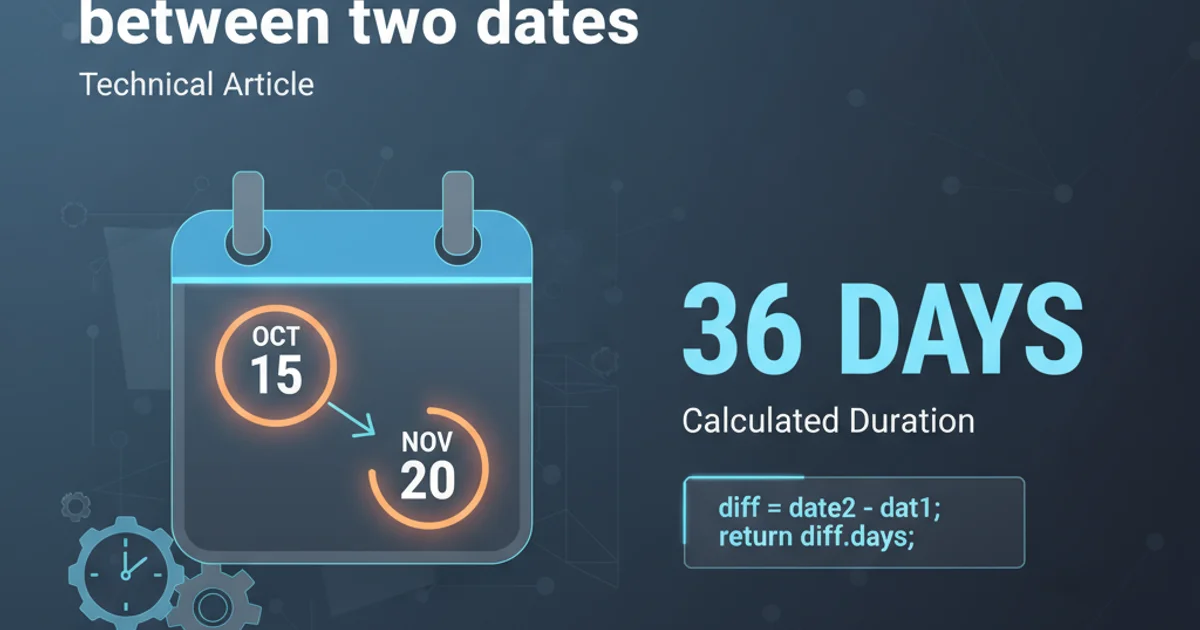Finding the number of days between two dates
Categories:
Calculating the Number of Days Between Two Dates in PHP

Learn how to accurately determine the difference in days between any two given dates using PHP's powerful DateTime objects and related functions.
Calculating the number of days between two dates is a common task in many applications, from scheduling systems to age calculators. PHP provides robust tools, primarily through its DateTime and DateInterval classes, to handle date and time manipulations with precision and ease. This article will guide you through the most reliable methods to perform this calculation, avoiding common pitfalls and ensuring accurate results.
Understanding PHP's DateTime Objects
Before diving into the calculation, it's crucial to understand PHP's DateTime objects. These objects offer a powerful, object-oriented way to represent and manipulate dates and times, overcoming many limitations of older, function-based approaches like strtotime() and date(). Using DateTime objects helps prevent issues related to timezones, daylight saving, and leap years, ensuring consistent results.
flowchart TD
A[Start] --> B{Create DateTime Objects};
B --> C{Define Start Date};
C --> D{Define End Date};
D --> E[Calculate DateInterval];
E --> F{Extract Days from Interval};
F --> G[Display Result];
G --> H[End];Flowchart illustrating the process of calculating days between two dates using DateTime objects.
Method 1: Using DateTime::diff()
The most recommended and straightforward method to find the difference between two dates is using the DateTime::diff() method. This method returns a DateInterval object, which contains various properties representing the difference, including years, months, days, hours, minutes, and seconds. For our purpose, we'll focus on the 'days' property.
<?php
$startDate = new DateTime('2023-01-15');
$endDate = new DateTime('2023-02-20');
$interval = $startDate->diff($endDate);
echo "Difference: " . $interval->days . " days";
// Output: Difference: 36 days
// Example with different order (still positive days)
$startDate2 = new DateTime('2023-02-20');
$endDate2 = new DateTime('2023-01-15');
$interval2 = $startDate2->diff($endDate2);
echo "\nDifference (reversed): " . $interval2->days . " days";
// Output: Difference (reversed): 36 days
// To get a signed difference, check the 'invert' property
if ($interval2->invert) {
echo "\nEnd date is before start date.";
}
?>
PHP code demonstrating the use of DateTime::diff() to calculate the number of days.
DateInterval object's days property always returns the absolute number of days. If you need to know if the end date is before the start date, check the invert property of the DateInterval object. It will be 1 if the interval represents a negative duration (end date is earlier than start date), and 0 otherwise.Method 2: Calculating with Timestamps (Less Recommended)
While DateTime::diff() is preferred, it's also possible to calculate the difference by converting dates to Unix timestamps, finding their difference in seconds, and then converting that difference to days. This method is generally less robust due to potential issues with timezones and daylight saving time if not handled carefully, but it can be useful for very simple scenarios or when working with older PHP versions.
<?php
$startDateString = '2023-01-15';
$endDateString = '2023-02-20';
$startTimestamp = strtotime($startDateString);
$endTimestamp = strtotime($endDateString);
if ($startTimestamp === false || $endTimestamp === false) {
die("Invalid date format.");
}
$differenceInSeconds = abs($endTimestamp - $startTimestamp);
$differenceInDays = floor($differenceInSeconds / (60 * 60 * 24));
echo "Difference: " . $differenceInDays . " days";
// Output: Difference: 36 days
?>
PHP code demonstrating date difference calculation using timestamps.
strtotime(), be aware that it can return false for invalid date strings. Always check the return value. Also, strtotime() can be affected by the server's timezone settings, which might lead to unexpected results if not explicitly managed.